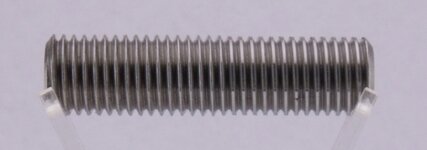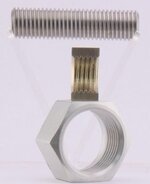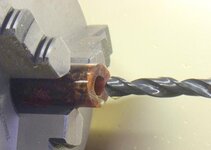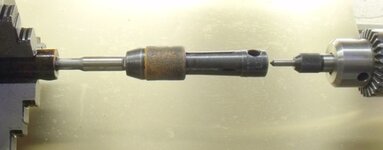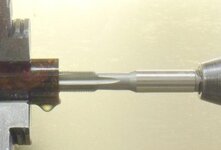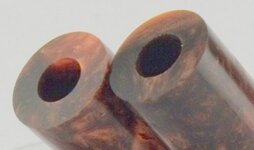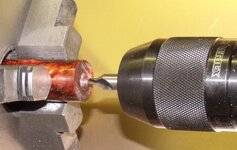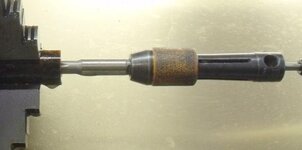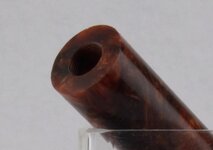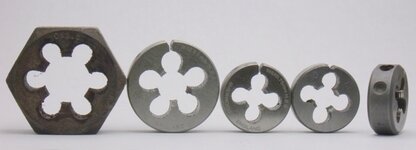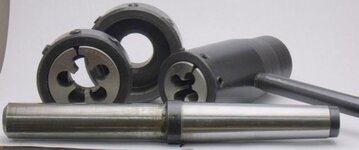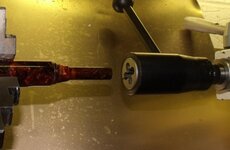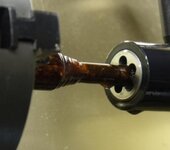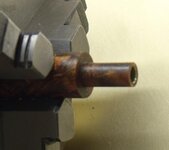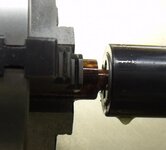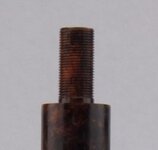Most of this stuff is pretty basic and I'm not even going to get into any technical jargon ( even if I knew it :redface but I figured this might help one or two people. I hope so, or I've just wasted a few hours when I could've made a pen or even had a beer. :biggrin:
but I figured this might help one or two people. I hope so, or I've just wasted a few hours when I could've made a pen or even had a beer. :biggrin:
Please also note that this is just the way I do things, I'm no expert and there are sure to be other and maybe better ways.:wink:
In this exciting episode, I'd like to share a couple of things about taps and how to use them in a lathe. I'll try and do something similar for dies, this weekend too.
I'd like to share a couple of things about taps and how to use them in a lathe. I'll try and do something similar for dies, this weekend too.
OK, lets look at a couple of taps. These are not anything special with regards to spiral flutes or even for special purposes. Just general purpose taps.
In the first pic (DifTaps.jpg) there is one very obvious difference between them. They have different names depending on where you live, but basically they are named after the amount of taper on the front.
You can see that the one on the left has very little taper. In fact this tap requires only about one or two turns to fully form the threads.
This is often the type of tap you will get in a Pound Shop ( Dollar Store )
But they do have a purpose. They are often called Bottom Taps, because they are used to thread to the bottom of a blind hole. The are also called 3rd cut taps, because if you need to thread to the bottom of a hole, it would be the third tap you use.
You shouldn't even attempt to start a thread with this kind of tap. You can be pretty sure that you will either strip the threads as you try or just break the workpiece.
Next tap has more taper, probably around 4 -5 turns before a thread is fully formed. These are pretty good taps and most of mine are like this.
They are often called Plug Taps or 2nd Cut Taps. These are not ideal for brittle stuff like PR, but can be used.
Next is my favourite. The long taper on these means that it is taking smaller bites out of the workpiece and needs several turns to form each thread. Because the thread is cut so gradually, they are ideal for our pen making purposes. Infinitely less stress on the work as the threads are cut.
In the next pic ( Edges.jpg) the taps are shown from the business end.
Another reason that I like this particular brand of tap is that it has four cutting edges which makes it even less aggresive.
If you understand about rake angles then note which taps offer a nice positive cutting angle. This is similar to the difference between using a skew instead of a scraper.
Next pic is a great little tool. It's called a Tapping Guide. (TapGuide.jpg)They are very cheap. It really is only a spring loaded pin. It keeps forward pressure on the tap while it enters the work but also keeps the tap aligned with the centre of the hole being tapped.
Next pic is the same tool but dismantled. (TapGuideDis.jpg)The pin can be reversed for different taps.
Next is the pin on its own with various taps. IMHO all good taps have a little hole in the end. Now you know why. The pin has a small hole in the end to guide taps that have a point on the end, but I have never seen points on anything but the smallest taps. The tap in the middle is chamfered on the end and I have searched high and low to find a Tap Guide that can take it. Pretty useless if your lathe bed is short.
Next is just a selection of my tap wrenches. With the exception of the T-Bar one in the front, can you spot what they all have in common??:wink:
You got it!!! They all have a little hole in the end. Mmmmm, I wonder why?:biggrin:
There a many ways to hold a tap in a lathe. (Important to remember is that the lathe is only used to keep everything aligned steadily. Of course the lathe MUST be switched off and preferably unplugged!!)
This is often determined by the length of your lathe bed. Do you remember when everyone kept saying to get the longest one you could afford?:wink:
My prefered method is with the T-Bar wrench. Don't worry if the T-bar is longer than the swing of your lathe. Just hold the wrench and rotate the work. :wink:
If you are stuck for space or don't have the wrench or tap guide, then you may be able to fully extend your tailstock so far that the little key dissengages and allows the shaft to rotate freely. This works well but has a couple of drawbacks. You have to re-align the keyway to get the spindle back in. And when you are re-winding the tap, it is easy to rip the first few threads out. But easy if you are careful.
I'll add some tricks about threading PR later if I get a chance. And add a bit about selecting the correct hole for the tap.
Please also note that this is just the way I do things, I'm no expert and there are sure to be other and maybe better ways.:wink:
In this exciting episode,
OK, lets look at a couple of taps. These are not anything special with regards to spiral flutes or even for special purposes. Just general purpose taps.
In the first pic (DifTaps.jpg) there is one very obvious difference between them. They have different names depending on where you live, but basically they are named after the amount of taper on the front.
You can see that the one on the left has very little taper. In fact this tap requires only about one or two turns to fully form the threads.
This is often the type of tap you will get in a Pound Shop ( Dollar Store )
But they do have a purpose. They are often called Bottom Taps, because they are used to thread to the bottom of a blind hole. The are also called 3rd cut taps, because if you need to thread to the bottom of a hole, it would be the third tap you use.
You shouldn't even attempt to start a thread with this kind of tap. You can be pretty sure that you will either strip the threads as you try or just break the workpiece.
Next tap has more taper, probably around 4 -5 turns before a thread is fully formed. These are pretty good taps and most of mine are like this.
They are often called Plug Taps or 2nd Cut Taps. These are not ideal for brittle stuff like PR, but can be used.
Next is my favourite. The long taper on these means that it is taking smaller bites out of the workpiece and needs several turns to form each thread. Because the thread is cut so gradually, they are ideal for our pen making purposes. Infinitely less stress on the work as the threads are cut.
In the next pic ( Edges.jpg) the taps are shown from the business end.
Another reason that I like this particular brand of tap is that it has four cutting edges which makes it even less aggresive.
If you understand about rake angles then note which taps offer a nice positive cutting angle. This is similar to the difference between using a skew instead of a scraper.
Next pic is a great little tool. It's called a Tapping Guide. (TapGuide.jpg)They are very cheap. It really is only a spring loaded pin. It keeps forward pressure on the tap while it enters the work but also keeps the tap aligned with the centre of the hole being tapped.
Next pic is the same tool but dismantled. (TapGuideDis.jpg)The pin can be reversed for different taps.
Next is the pin on its own with various taps. IMHO all good taps have a little hole in the end. Now you know why. The pin has a small hole in the end to guide taps that have a point on the end, but I have never seen points on anything but the smallest taps. The tap in the middle is chamfered on the end and I have searched high and low to find a Tap Guide that can take it. Pretty useless if your lathe bed is short.
Next is just a selection of my tap wrenches. With the exception of the T-Bar one in the front, can you spot what they all have in common??:wink:
You got it!!! They all have a little hole in the end. Mmmmm, I wonder why?:biggrin:
There a many ways to hold a tap in a lathe. (Important to remember is that the lathe is only used to keep everything aligned steadily. Of course the lathe MUST be switched off and preferably unplugged!!)
This is often determined by the length of your lathe bed. Do you remember when everyone kept saying to get the longest one you could afford?:wink:
My prefered method is with the T-Bar wrench. Don't worry if the T-bar is longer than the swing of your lathe. Just hold the wrench and rotate the work. :wink:
If you are stuck for space or don't have the wrench or tap guide, then you may be able to fully extend your tailstock so far that the little key dissengages and allows the shaft to rotate freely. This works well but has a couple of drawbacks. You have to re-align the keyway to get the spindle back in. And when you are re-winding the tap, it is easy to rip the first few threads out. But easy if you are careful.
I'll add some tricks about threading PR later if I get a chance. And add a bit about selecting the correct hole for the tap.
Attachments
-
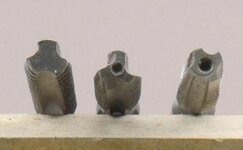 Edges.jpg19.9 KB · Views: 645
Edges.jpg19.9 KB · Views: 645 -
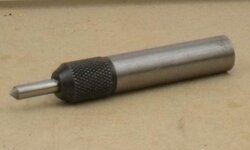 TapGuide.jpg18.1 KB · Views: 679
TapGuide.jpg18.1 KB · Views: 679 -
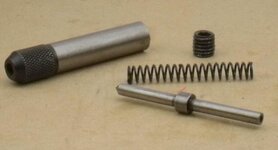 TapGuideDis.jpg20 KB · Views: 798
TapGuideDis.jpg20 KB · Views: 798 -
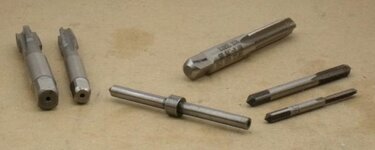 PinHole.jpg16.7 KB · Views: 660
PinHole.jpg16.7 KB · Views: 660 -
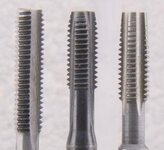 DifTaps.jpg26.5 KB · Views: 702
DifTaps.jpg26.5 KB · Views: 702 -
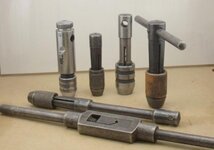 Wrenches.jpg25.3 KB · Views: 891
Wrenches.jpg25.3 KB · Views: 891 -
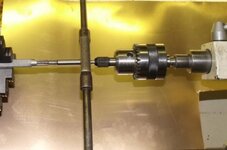 TBarWrench.jpg25.9 KB · Views: 1,115
TBarWrench.jpg25.9 KB · Views: 1,115 -
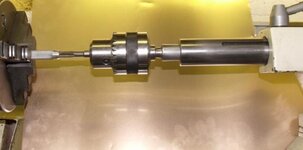 Tailstock.jpg20.3 KB · Views: 903
Tailstock.jpg20.3 KB · Views: 903 -
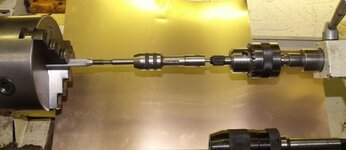 ColletWrench.jpg84 KB · Views: 916
ColletWrench.jpg84 KB · Views: 916

